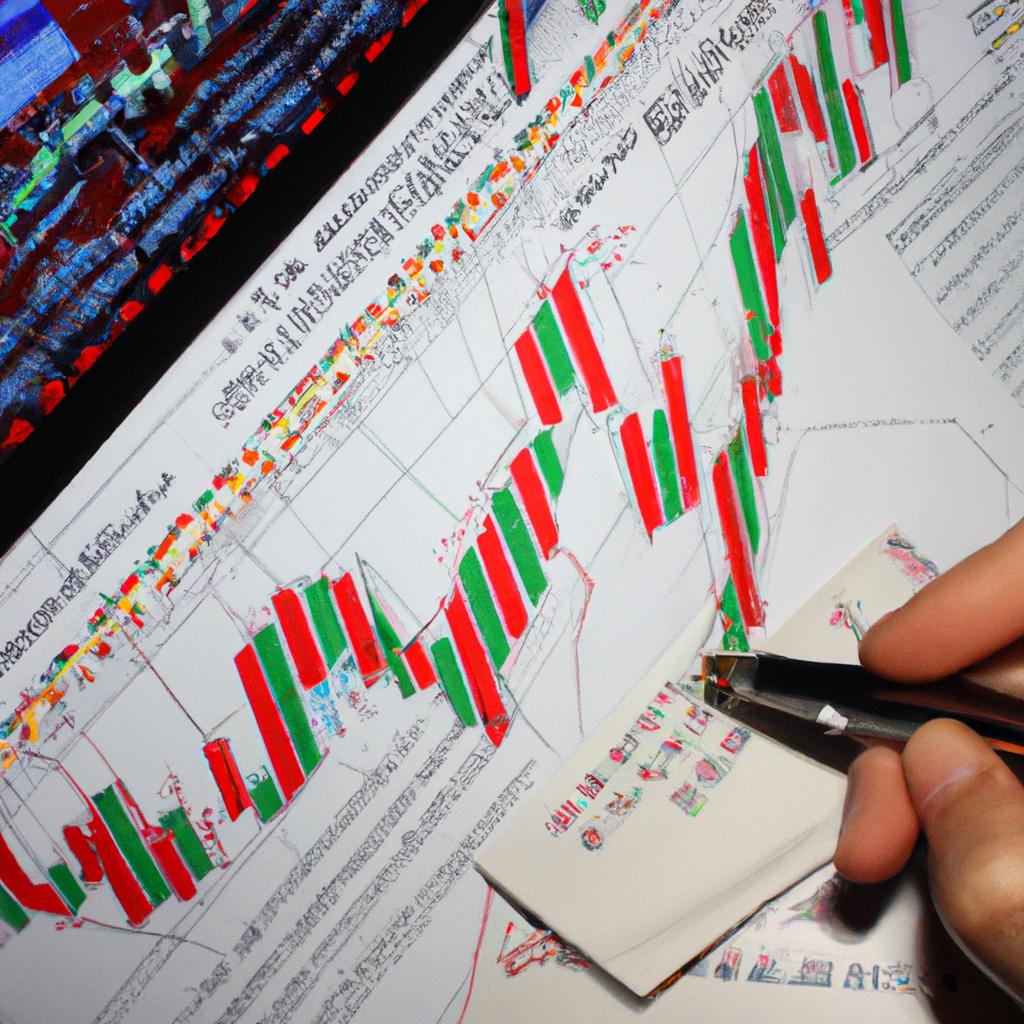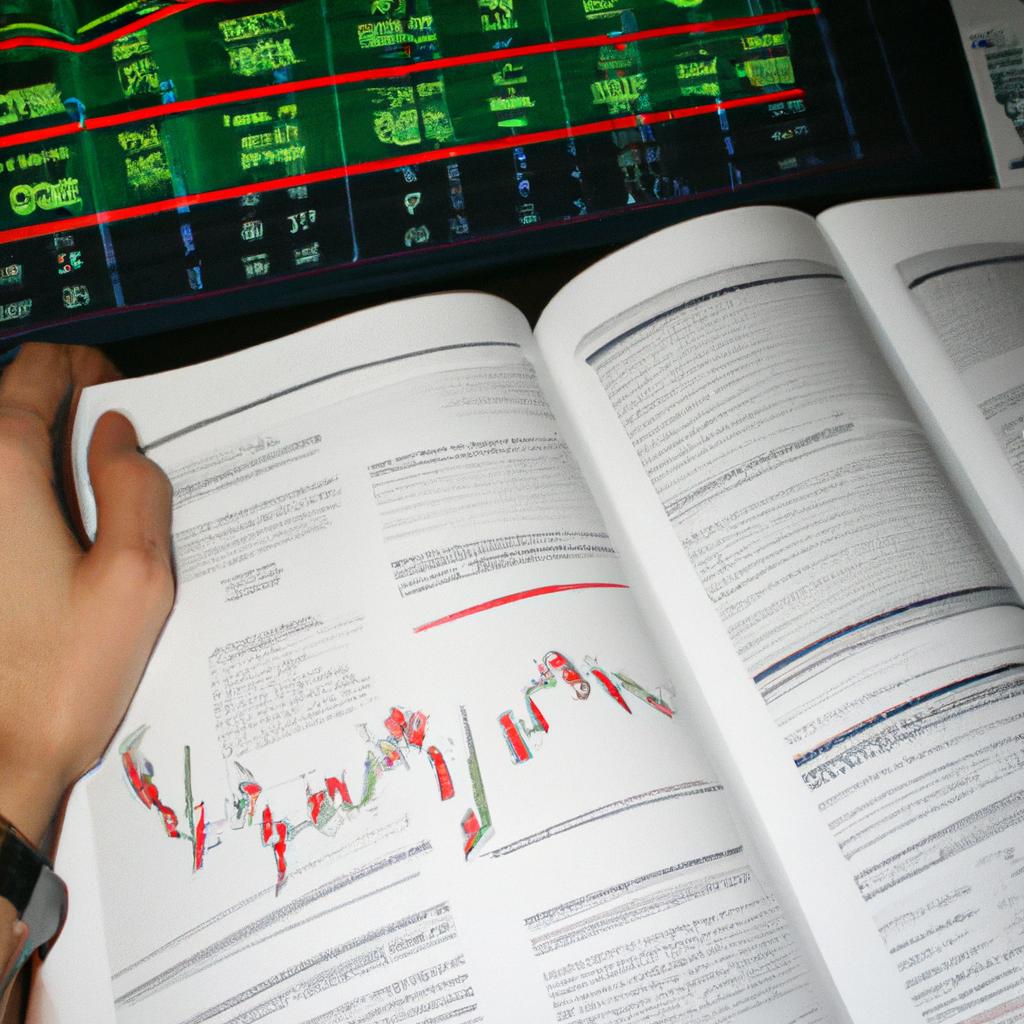Commodity Price Volatility: A Key Element in Investing in Business Commodities

Commodity price volatility is a critical factor that investors must consider when engaging in business commodities. The unpredictable fluctuations in commodity prices can have significant implications on investment decisions and overall profitability. For instance, let us consider the case of Company X, which specializes in the production and distribution of crude oil. Over the past decade, Company X has witnessed substantial variations in oil prices, leading to both favorable and challenging market conditions. This example highlights how commodity price volatility can be a key determinant for businesses operating within the commodities sector.
Understanding the dynamics of commodity price volatility is crucial for investors seeking optimal returns and risk management strategies. In recent years, global markets have experienced heightened uncertainty due to various factors such as geopolitical tensions, economic fluctuations, and environmental concerns. These external forces often trigger sharp movements in commodity prices across different sectors ranging from energy to agriculture. As a result, businesses involved in trading or producing commodities face inherent risks associated with these volatile price patterns. Therefore, comprehending the nature of commodity price volatility becomes imperative not only for companies directly exposed to commodities but also for investors who seek lucrative opportunities amidst ever-changing market conditions.
In this article, we will explore the concept of commodity price volatility from an investing perspective. We will delve into its causes and consequences, examining the impact it has on investment decisions and strategies. Furthermore, we will discuss various approaches that investors can adopt to effectively manage and mitigate the risks associated with commodity price volatility.
Causes of Commodity Price Volatility:
Commodity prices are influenced by a multitude of factors, making them inherently volatile. Some key drivers of commodity price volatility include:
-
Supply and Demand Imbalances: Fluctuations in supply and demand dynamics can significantly impact commodity prices. For example, geopolitical tensions or natural disasters can disrupt supply chains, leading to shortages or excess inventory, thereby causing price fluctuations.
-
Macroeconomic Factors: Economic conditions, such as inflation, interest rates, and currency exchange rates, can influence commodity prices. Changes in these macroeconomic indicators can affect the purchasing power of consumers and businesses, resulting in shifts in demand for commodities.
-
Weather Conditions: Commodities like agricultural products are heavily dependent on weather conditions. Droughts, floods, or extreme temperatures can impact crop yields and ultimately affect prices.
-
Speculation and Investor Sentiment: The behavior of market participants who speculate on future price movements can contribute to heightened volatility. Investor sentiment driven by factors like news events or market expectations can amplify price swings.
Consequences of Commodity Price Volatility:
The consequences of commodity price volatility extend beyond the commodities sector itself and have broader implications for various stakeholders:
-
Businesses: Companies engaged in producing or trading commodities face significant challenges when prices fluctuate unpredictably. Higher input costs or lower revenues due to falling prices can impact profitability and financial stability.
-
Investors: Commodity price volatility adds an additional layer of risk for investors involved in commodities markets. It requires careful monitoring and analysis to identify opportunities for profitable investments while managing downside risks.
-
Consumers: Fluctuating commodity prices directly influence consumer goods’ cost structures, impacting affordability across industries such as energy, food, and transportation.
-
Governments: Governments must navigate the consequences of commodity price volatility, such as inflationary pressures or budget constraints due to changing revenues from commodity exports.
Strategies for Managing Commodity Price Volatility:
To effectively manage the risks associated with commodity price volatility, investors can employ various strategies:
-
Diversification: Spreading investments across different commodities and sectors can help mitigate risk exposure to individual price fluctuations.
-
Hedging: Utilizing derivative instruments like futures contracts or options can provide protection against adverse price movements by locking in prices at a future date.
-
Fundamental Analysis: Conducting thorough research on supply-demand dynamics, macroeconomic trends, and geopolitical factors can aid in identifying potential market trends and making informed investment decisions.
-
Risk Management Tools: Using risk management tools like stop-loss orders or trailing stops can help limit potential losses by automatically selling positions if prices reach predetermined levels.
-
Long-Term Perspective: Taking a long-term investment approach reduces the impact of short-term price volatility and allows investors to capture broader market trends.
In conclusion, commodity price volatility is a critical factor that investors must consider when engaging in business commodities. Understanding its causes and consequences is essential for making informed investment decisions and implementing effective risk management strategies. By diversifying portfolios, utilizing hedging techniques, conducting thorough analysis, and adopting a long-term perspective, investors can navigate the challenges posed by commodity price volatility while seeking profitable opportunities in ever-changing markets.
Understanding commodity price volatility
Understanding commodity price volatility is crucial for investors and businesses involved in the trading of commodities. Commodity markets are known for their inherent uncertainty, as prices can fluctuate significantly within short periods of time. To illustrate this point, let us consider a real-life example: the oil market crash of 2014-2016. During this period, the price of crude oil plummeted from over $100 per barrel to below $30 per barrel, causing financial distress for many oil-producing nations and companies worldwide.
Commodity price volatility arises due to various factors that affect supply and demand dynamics. These factors include geopolitical events, changes in global economic conditions, weather patterns affecting agricultural produce, technological advancements impacting production capabilities, and government policies regulating trade. The complex interplay between these elements contributes to the unpredictable nature of commodity prices.
To further emphasize the significance of understanding commodity price volatility, we present a bullet-point list highlighting its implications:
- Risk exposure: Investors face increased risk when dealing with volatile commodities.
- Profit potential: Volatility presents opportunities for profit if successfully anticipated and managed.
- Supply chain disruptions: Businesses reliant on commodities may experience challenges due to sudden price fluctuations.
- Macroeconomic impact: Commodity price movements have broader economic consequences at both national and international levels.
In addition to bullet points, a table can also be used effectively to convey information concisely. Here is an example illustrating different types of commodities along with their historic volatility levels:
| Commodity | Historic Volatility |
|---|---|
| Oil | High |
| Gold | Moderate |
| Wheat | Low |
| Natural Gas | High |
By analyzing such data, investors gain insights into which commodities tend to exhibit higher or lower levels of volatility. This knowledge helps inform investment decisions and risk management strategies.
In conclusion, comprehending commodity price volatility is essential for anyone involved in investing or trading commodities. The dynamic nature of commodity markets, influenced by a multitude of factors, necessitates careful analysis and understanding. In the subsequent section, we will delve into the various factors that contribute to commodity price volatility and explore their impact on market dynamics.
Factors influencing commodity price volatility
Understanding commodity price volatility is crucial for investors looking to make informed decisions when investing in business commodities. This section will explore the factors that influence commodity price volatility, highlighting its significance and impact on investment strategies.
To illustrate the importance of understanding commodity price volatility, let us consider a hypothetical case study involving a multinational corporation involved in the production of steel. The company relies heavily on iron ore as one of its key raw materials. Suppose there is an unexpected disruption in the supply of iron ore due to political unrest in major exporting countries. This disruption leads to a sharp increase in the price of iron ore, impacting the cost structure of the corporation and ultimately affecting its profitability.
Several factors contribute to commodity price volatility, making it essential for investors to be aware of their implications. These factors include:
- Supply and demand imbalances: Fluctuations in global supply and demand dynamics can significantly impact commodity prices. Changes in production levels, technological advancements, geopolitical events, natural disasters, or shifts in consumer preferences all play a role.
- Speculation and investor sentiment: Commodity markets are influenced by speculation and investor sentiment, leading to short-term fluctuations that may not align with underlying fundamentals.
- Macroeconomic indicators: Economic indicators such as GDP growth rates, inflation levels, interest rates, and exchange rate movements have a direct bearing on commodity prices.
- Government policies and regulations: Policies related to trade restrictions, subsidies, taxes, or environmental regulations can introduce uncertainty into commodity markets.
The table below provides a visual representation of how different factors can affect specific commodities:
| Commodities | Factors Influencing Price Volatility |
|---|---|
| Crude oil | Geopolitical tensions |
| Gold | Global economic stability |
| Corn | Weather conditions |
| Copper | Infrastructure development |
Understanding these various factors allows investors to gauge potential risks associated with commodity price volatility and develop appropriate risk management strategies. By monitoring and analyzing these factors, investors can make informed decisions regarding the timing of their investments or hedging strategies to mitigate potential losses.
As we have seen, commodity price volatility is a key element in investing in business commodities. The ability to anticipate and respond to fluctuations in prices can greatly impact investment outcomes. In the subsequent section, we will explore the specific impacts of commodity price volatility on businesses and how they navigate this dynamic landscape.
Impact of commodity price volatility on businesses
Factors influencing commodity price volatility can have a significant impact on businesses that invest in commodities. Understanding these factors is crucial for investors to make informed decisions and mitigate potential risks. One example of such volatility can be seen in the case of oil prices during the global financial crisis of 2008.
During this period, the demand for oil decreased due to reduced economic activities worldwide, resulting in a surplus supply. This imbalance caused a sharp decline in oil prices, which had a profound effect on various industries reliant on this commodity. For instance, airlines faced increased operating costs as jet fuel prices soared before eventually stabilizing at lower levels. This real-world example highlights the importance of analyzing and anticipating factors that contribute to commodity price volatility.
There are several key elements that influence commodity price volatility:
-
Supply and Demand Dynamics: Fluctuations in supply and demand play a crucial role in determining commodity prices. Factors such as natural disasters, geopolitical tensions, changes in consumer behavior, and technological advancements can all affect both supply and demand dynamics.
-
Macroeconomic Factors: Global economic conditions greatly impact commodity prices. Inflation rates, interest rates, exchange rates, and overall economic growth or recessionary periods can significantly influence investor sentiment towards commodities.
-
Speculation and Investor Sentiment: The actions of speculators and investors can introduce additional volatility into commodity markets. Market speculation based on anticipated future events or trends can cause rapid price fluctuations.
-
Government Policies: Government regulations, trade policies, subsidies, taxes, and export restrictions imposed by countries involved in the production or consumption of specific commodities can also lead to price volatility.
To further illustrate the significance of these factors on different industries’ profitability when investing in business commodities we present a table showcasing four examples:
| Industry | Commodity | Impact |
|---|---|---|
| Agriculture | Wheat | Droughts affecting crop yields |
| Manufacturing | Copper | Political instability disrupting mining |
| Energy | Natural Gas | Technological advancements boosting supply |
| Construction | Lumber | Environmental regulations limiting production |
This table demonstrates how various industries can be affected differently by commodity price volatility, emphasizing the importance of understanding these factors to make informed investment decisions.
In light of the potential risks posed by commodity price volatility, businesses need to develop strategies that allow them to manage and mitigate these fluctuations effectively. The subsequent section will delve into some key strategies adopted by companies to navigate through such uncertainties without compromising their financial stability or profitability.
Strategies to manage commodity price volatility
Impact of Commodity Price Volatility on Businesses
Commodity price volatility can have a significant impact on businesses across various industries. To illustrate this point, let us consider the case of Company XYZ, a global manufacturer that relies heavily on raw materials such as copper and steel to produce its goods. In recent years, fluctuations in commodity prices have presented both opportunities and challenges for Company XYZ.
Firstly, when commodity prices experience sudden increases, Company XYZ faces higher production costs due to the elevated cost of raw materials. This leads to reduced profit margins and may even render certain product lines unprofitable. For instance, during a period of high copper prices, the cost of manufacturing electrical components using copper skyrocketed for Company XYZ. As a result, they had to either increase the selling price or absorb the additional costs themselves.
Conversely, when commodity prices decline sharply, there is potential for cost savings and increased profitability for companies like Company XYZ. However, these benefits are not always immediate or guaranteed. The company may have already purchased raw materials at higher prices before the decline occurred, resulting in inventory losses. Moreover, if competitors also take advantage of lower input costs by lowering their own prices, it can lead to intensified competition and decreased market share for Company XYZ.
Therefore, managing commodity price volatility becomes crucial for businesses seeking stability and success amidst fluctuating markets. Here are some strategies that companies employ:
- Diversification: Companies with exposure to multiple commodities can mitigate risks by spreading them across different products.
- Hedging: Utilizing financial instruments such as futures contracts allows businesses to lock in favorable pricing terms in advance.
- Long-term contracts: Establishing long-term agreements with suppliers provides stability in procurement costs over an extended period.
- Inventory management: Maintaining optimal levels of inventory helps reduce vulnerability to sudden changes in commodity prices.
By incorporating these strategies into their operations, businesses can navigate through periods of heightened commodity price volatility more effectively. However, it is important to note that there are no one-size-fits-all solutions. The effectiveness of these strategies depends on the specific industry and market conditions.
In the subsequent section, we will explore the importance of risk assessment in commodity investments and how businesses can evaluate potential risks before making investment decisions. By analyzing various elements such as supply-demand dynamics and geopolitical factors, companies can make informed choices that minimize their exposure to price volatility and maximize profitability in this complex landscape.
Importance of risk assessment in commodity investments
To effectively navigate the challenges posed by commodity price volatility, businesses must adopt strategic approaches that mitigate risk and maximize potential gains. By employing a range of strategies, companies can safeguard their investments while capitalizing on market fluctuations. One example of such a strategy is hedging, which involves using financial instruments like futures contracts or options to offset potential losses caused by adverse price movements.
Hedging serves as an effective tool for managing commodity price volatility due to its ability to provide stability in uncertain markets. For instance, consider a hypothetical case study where Company X operates in the agricultural sector and relies heavily on corn as its primary input. In anticipation of rising corn prices during periods of drought, Company X decides to hedge its exposure by entering into futures contracts at current market rates. As a result, even if corn prices surge due to weather-related factors, the company’s bottom line will remain protected from significant losses.
Moreover, diversification is another key strategy employed by businesses seeking to minimize their vulnerability to commodity price volatility. Diversifying across different commodities helps spread risk and reduces dependence on any single market. Companies that engage in diversification often invest in various commodities with dissimilar pricing patterns or unrelated demand drivers. This approach enables them to capture opportunities arising from favorable price movements in one commodity while mitigating losses incurred due to unfavorable price changes in another.
In order to successfully implement these strategies and effectively manage commodity price volatility, it is crucial for businesses to conduct comprehensive risk assessments. Understanding the specific risks associated with each investment allows companies to make informed decisions regarding allocation of resources and adoption of appropriate mitigation measures. Some key factors that should be considered during risk assessment include:
- Market dynamics: Assessing supply-demand imbalances and geopolitical factors impacting global trade.
- Regulatory environment: Evaluating policies related to import-export restrictions or subsidies that could influence prices.
- Technological advancements: Recognizing how technological innovations might disrupt existing supply chains and impact commodity prices.
- Climate change: Recognizing the potential effects of climate-related events on agricultural commodities, such as droughts or floods.
By undertaking risk assessments that incorporate these factors, businesses can develop a well-rounded understanding of the risks they face and tailor their strategies accordingly. This approach ensures a proactive response to market fluctuations and enhances resilience in the face of commodity price volatility.
The role of diversification in mitigating commodity price risk will be explored further in the subsequent section, examining how it complements other risk management strategies to create robust investment portfolios.
The role of diversification in mitigating commodity price risk
Having discussed the importance of risk assessment in commodity investments, it is crucial to explore strategies that can help mitigate the impact of price volatility. One such strategy is diversification, which provides investors with a means to spread their exposure across different commodities and hence reduce overall portfolio risk.
Diversification involves investing in a variety of commodities that have low or negative correlations with each other. This approach aims to limit potential losses by not relying solely on one specific commodity’s performance. To illustrate this concept, consider a hypothetical case study where an investor has a portfolio consisting primarily of oil-related commodities. If there is a sudden decrease in global oil demand due to geopolitical tensions, the investor’s entire portfolio would be significantly impacted. However, if the same investor had diversified their holdings by including non-oil related commodities like agricultural products or metals, the negative impact of falling oil prices could be partially offset.
The following bullet points highlight some key reasons why diversification can play a vital role in mitigating commodity price risk:
- Spread risk: By investing across multiple commodities, investors are less exposed to significant losses caused by adverse events affecting only one particular sector.
- Potential for higher returns: Diversified portfolios have historically shown greater resilience during periods of high commodity price volatility compared to concentrated portfolios.
- Enhanced flexibility: A well-diversified portfolio allows investors to capitalize on opportunities arising from fluctuations in various commodity markets while minimizing potential downside risks.
- Reduced market timing dependence: Rather than trying to predict future price movements accurately, diversification enables investors to focus more on long-term trends and fundamental factors driving each individual commodity.
To further emphasize the benefits of diversification visually, let us consider the table below showcasing three hypothetical investment scenarios over a five-year period:
| Scenario 1 | Scenario 2 | Scenario 3 | |
|---|---|---|---|
| Commodity A | 10% return | -5% return | 15% return |
| Commodity B | -2% return | 12% return | -8% return |
| Commodity C | 6% return | -3% return | 9% return |
| Commodity D | -4% return | 8 %return | 7 %return |
In Scenario 1, where the portfolio is concentrated solely in one commodity (Commodity A), a positive outcome of a 10% return is achieved. However, the negative returns in Scenarios 2 and 3 demonstrate that concentrating investments can lead to potential losses.
In contrast, by diversifying across all four commodities as shown in Scenario 3, investors benefit from higher overall returns despite individual commodities experiencing mixed results. This table serves as an illustration of how diversification can help smooth out volatility and reduce risk exposure.
In conclusion, diversification plays a crucial role in mitigating commodity price risk. By spreading investments across different commodities with low correlations, investors can enhance their portfolios’ resilience against adverse events impacting specific sectors. The benefits of diversification include reduced market timing dependence, increased flexibility, potential for higher returns, and better risk management overall. Incorporating this strategy into commodity investing allows for more stable long-term performance while minimizing exposure to unpredictable price fluctuations.






